Free Astronomy Resources
Free Astronomy Resources
Astronomy
Astronomy Lecture Powerpoints
Astronomy Lecture Notes (Textbook-Like)
Astronomy Notes
Astronomy Lecture Notes (Alaska)
Astronomy Lecture Powerpoints (Trinity)
Astronomy Lecture Notes (MIRA)
Astronomy Lecture Powerpoints (Rutten)
Modern Astronomy Lecture Notes
Astronomy Lecture Powerpoints (Wickman)
Solar System Astronomy Lecture Notes
Astronomy Lecture Notes
Astronomy Lecture Notes (Mitchell)
Astronomy Lecture Notes (Rochester)
Time Systems Lecture Notes
Earth and Sky Notes
Galactic Structure and Stellar Populations Lecture Notes
Stars, Galaxies, and the Universe Lecture Notes
Astronomical Techniques
Essential Radio Astronomy
Introduction to Astronomy
Physics
Equations and Formulas
Essential Physics Equations
MCAT Physics Equations
Frequently Used Physics Equations
General Physics Notes
Physics Lecture Notes (MIT)
University Physics (Textbook-Like)
General Physics I
Physics Lecture Notes (Colorado)
Physics Lecture Notes (Rochester)
Physics Lecture Notes (Cabrillo)
Physics Lecture Notes (Trinity)
Physics Notes
Physics Videos (Flipping Physics)
Physics Ch 1 to 8 Lecture Notes
Feynman Physics Lecture Notes
Electromagnetism
Electromagnetism Lecture Notes
Feynman Electromagnetism and Matter Lecture Notes
Mechanics
Mechanics (Physics) Lecture Notes
Mechanics (Physics) Powerpoint Slides
Feynman Quantum Mechanics Lecture Notes
Physics and Astronomy
Physics of the Interstellar Medium Lecture Notes
Physics for Astronomy Lecture Notes (Textbook-Like)
Radio Astronomy (Physics 728)
Physics: Astronomy, Astrophysics, and Cosmology
Inorganic Chemistry
Inorganic Chemistry Chapter Notes
Inorganic Chemistry Lecture Notes
Inorganic Chemistry 2 Lecture Notes
Advanced Inorganic Chemistry Lecture Notes
Calculus
Formulas and Equations
Calculus Cheat Sheet
AP Calculus Basic Formulas and Properties
Calculus 1 Formulas
Basic Calculus: Rules and Formulas (Video)
Differential Formulas
Integral Calculus Formulas
The Basics
Basic Calculus Refresher
Single Variable Calculus
Multivariable Calculus (Textbook-like)
Basics of Calculus (Textbook-like)
Calculus for Beginners
Calculus 1
Calculus (Textbook-like)
Calculus 1 (Textbook-like)
Calculus 1 Video Lectures
Calculus 1 Lecture Notes
Calculus 1 Lecture Notes (Northern Illinois)
Calculus 1 Lecture Notes (Citadel)
Calculus 1 Compact Lecture Notes
Calculus Lecture Notes (Raz Kupferman)
Introduction to Calculus Lecture Notes
Calculus 2
Calculus 2 Lecture Notes
Calculus 2 Lecture Notes (Northern Illinois)
Calculus 2 Notes (Illinois State)
Calculus 2 Lecture Notes (McClendon)
Calculus 2 Lecture Notes (Textbook-like)
Calculus 2 (Textbook-like) (Dawkins)
Calculus 2 Lecture Videos
Calculus 2 Class Notes
Calculus 2 Materials (Notes, Handouts, Etc.)
Calculus 3
Calculus 3 Lecture Notes (Lamar)
Calculus 3 Lecture Videos
Calculus 3 (Dawkins)
Calculus 3 (Notes, Homework, Quizzes)
Notes for Calculus 3
Calculus 3 Class Notes
Other Calculus
Integral Calculus Lecture Notes
Algebra and Differential Calculus
Differential and Integral Calculus (Textbook)
Differential and Integral Calculus (Lecture Notes & Old Exams)
Computer Science Calculus Lecture Notes
Calculus for Physics C
Analytic Geometry and Calculus 2
History
Notes on the History of Astronomy
History of Astronomy Powerpoint
Early History of Astronomy
History of Radio Astronomy
NASA History
Neolithic Astronomy
Mesopotamian Astronomy
Islamic Astronomy
Indian Astronomy
Greek Astronomy
Chinese Astronomy
Egyptian Astronomy
Mayan Astronomy
Space Agencies
National Aeronautics and Space Administration
South African National Space Agency
Canadian Space Agency
National Space Research and Development Agency
Italian Space Agency
Norwegian Space Center
Korea Aerospace Research Institute
Japan Aerospace Exploration Agency
UK Space Agency
Australian Space Agency
More Posts from Purpletelescope and Others
Achievements of 2021 (both academic and non-academic)
I'm still very much on break (basically just eating, sleeping, reading and swimming, it's delightful), but I want to sum up this year. It's been a fucking rollercoaster of a year and I still can't believe like half of the things that happened, both good and bad. Nevertheless, I want to focus on the positive ones to kickstart the new year in the most uplifting manner I'm able to pull off. Which is not very optimistic nor uplifting, but I can be at least not full of doom, haha.
I want to do this chronologically, just because I tend to forget the good stuff that happened more than two months ago.
Let's wrap this up!
Academic Achievements of 2021
presented at my first international conference (February)
prepped two PhD dissertation projects (April) and successfully defended them during the PhD programs interview (June)
wrote my diploma thesis while cooperating with the best mentor ever (January till June)
got accepted to two PhD programs and currently doing both of them! (June)
co-written three papers over the summer - two already published, one under a promising peer review (June-September)
defended my thesis and passed my state exams with straight As, meaning I got my master's degree! (September)
wrote a book chapter that got accepted (November)
Non-Academic Achievements of 2021
quit the job I hated (January)
got rid off so much stuff I didn't need (mostly July, August)
read 130 books, yaaay
stopped saying yes to meetings with acquaintances just because I felt like I should see them (big one!)
found a functioning skincare routine (September)
started swimming again (and loving it) (September)
A lot of this year has been mostly about surviving, to be honest. I was battling a lot of anxiety and depression, I was extremely stressed at times and couldn't sleep. Swimming and taking proper days off helps, close friends help. I'm gonna do a post with some goals for 2022, so I won't spoil here that, haha.
It was a good year after all.
Take care!
M.
Bonus post: Thesis writing.
This post will be a combination of tips and tricks I have received from numerous sources, with the majority coming from Shinton Consulting and STREAM IDC staff.
The big T
If you’re anything like me, just the word ‘thesis’ can instill a sense of dread in me. However, the best way to deal with a phobia is to face it head on, so let’s do just that, both in a literal and metaphorical sense.
What a thesis is and what to expect…
Writing a thesis could take anywhere between four weeks to a whole year, and sometimes even longer! The worst thing you can do is compare your progress to that of others; setting a benchmark is one thing, but beating yourself into a panicked pulp because you haven’t written as many chapters as a fellow PhD/EngD won’t do you any good. The best thing you can do is have regular discussions with your supervisors on how long your thesis will take and plan accordingly. 🕖
Your thesis has to be fit for purpose (that is to pass), which means that it has to:
Satisfy the expectations of your institution and industry sponsor (if applicable).
How did you solve the problem that was proposed to you?
Contain material which presents a unified body of work that could reasonably be achieved on the basis of three years’ postgraduate study and research.
Show you have done the work and impress your examiners.
Allow your examiners to confirm that the thesis is an original work, which makes a significant contribution to the field, including material worthy of publication.
Research your examiners and quote them where possible, especially of they’re relevant to your field.
Show adequate knowledge of the field of study and relevant literature.
Make sure you read all of the key papers in your field.
What were the gaps in knowledge?
The ‘references’ section is very important as this sets the scene and examiners will read this. BUT, don’t have too many references.
Demonstrate critical judgement with regard to both the candidate’s work and that of other scholars in the same general field.
Compare approaches and conclusions of others.
Note potential conflicts of interest.
Why did you use this method/approach?
Is your interpretation the only possible explanation?
Be presented in a clear, consistent, concise, and accessible format.
Make your examiners lives easier.
Make your viva as pleasant as can be!
Basically, you need to know why your project was important, be able to explain the key work that has already been done in the area and how it relates to your research aim. You should then be able to explain what you have done during your research and how this contributes to your field.
Note: Keep checking university regulations! Each university should have their own code of practice for supervisors and research students, which will look something like this.
Picture: A short summary of the above. Source: Tumblr.

Planning and writing
I’m not going to lie to you, it is not going to be easy. I have only just embarked on the journey myself and am already overwhelmed. However, with the right preparation, coping mechanisms in place, and a tremendous amount of self-discipline, we will get through. ☕
Getting started
You need to practice writing. That’s as simple as advice gets.
You need to practice reading other PhD/EngD theses, mainly to understand what to expect, and to experience what being the audience for a thesis is like.
Create a thesis plan…
To start the mammoth task that is thesis writing, it needs to be fully understood and broken down into manageable chunks.
Make a plan (perhaps based on the table of contents of another thesis) of all the sections and chapters in the thesis.
Then break these into sections and keep breaking it down until you are almost at the paragraph level.
Now you can start writing!
Where to start the actual writing?
Start with the most comfortable chapter, such as a previously published paper, a set of results that are straightforward and can be easily explained, methodology/methods, etc.
Create a storyboard for you thesis and write as if you are telling that story.
If you’re not sure what comes next, refer to previous theses and back to your plan and storyboard.
Be ready to amend the plan for future chapters as each is completed and you become more aware of what the thesis must contain.
Remember: THINKING IS HARD, WRITING IS EASIER. 💭
Organisation
Develop and maintain a logical filing system.
Improve your back up technique; if it’s not saved in 3+ locations, it is not safely backed up.
Back up every day.
Never overwrite previous documents, just make many versions. It’s not worth the risk of losing a valuable piece of work from a copy and paste error.
Copy any key parts from your lab/note/field books as these can get lost/damaged.
Keep a file/folder of thoughts, references, etc. that you are not including in your thesis; these may be useful to refer back to for ideas and information.
Effective writing
Establish a routine, don’t be distracted, take breaks.
Set clear and realistic goals for each week/day.
A GANTT chart is very good for this; use it to keep on track and measure progress.
You just gotta start. The hardest part is the beginning.
Don’t stall on details, walk away for a short break to clear your mind.
Get formatting correct from the start (check your code of practice/regulations).
Be consistent with references.
Seek help from the experts - supervisors, postdocs, online sources/training programmes etc.
Create SMART objectives for your writing process:
Specific - e.g. “I will complete chapter 3/collate all diagrams” rather than “I will make good progress”.
Measurable - e.g. “I will write 4 pages today” not “I will try to write as much as I can”.
Achievable - e.g. “I will complete the first draft for my supervisor” not “I will get it perfect before he/she sees it”.
Realistic - e.g. “I will complete the introduction today” not “I will complete a chapter a week”.
Time - it can be useful to set yourself deadlines e.g. tell your supervisor you will hand in a draft on a certain day - that way you are sure to have it done.
Finally, find a balance between being tough with yourself whilst protecting your well-being the best you can. I wrote a post a little while ago that covers managing your mental health during a PhD. Read it here.
GIF: Anna Kendrick dishing out some top advice. Source: Tumblr.

A few more tips
Supervisor management
Establish what you want to cover in each meeting.
Keep a record of the outcomes and actions from those meetings.
Make your supervisors lives easy; they’re very busy humans.
They are unlikely to judge work unless it is presented completely (i.e. fully written with tables, figures, etc.).
Give them a neat, complete version of a chapter at a time (proof-read thoroughly and spell-checked).
It is in your supervisors interest for you to complete in good time; they are experts and will offer a lot of support.
To summarise, a good thesis:
Has an appreciation of what came before.
Focuses on the interesting and important.
Is well reasoned.
Will change the way people think.
Will teach your supervisors something.
Has publishable results.
Is logical in presentation, analysis, and arguments.
Is well illustrated with tables, figures, graphs, summary flow charts etc.
It is worth spending a lot of time on these.
Is written without grammatical and spelling errors.
Has an appreciation of what comes next.
I hope that the above was helpful! There are many resources out there, so get exploring if you need more advice!
I’ll soon be writing a post on how to survive your viva! So, watch this space. ✨
Photo: Make this your phone/desktop/laptop/everything background when you’re writing, I know I will! Source: Tumblr.



11.01.21 - day 2? / monday motivation and a double shot of expresso;; my project is off to a fairly good start! My review for e&m isn’t going as well, but I’ll still try to work on it and hopefully get to review some quantum before tomorrow too. Didn’t even have classes today but I am exhausted:^) well, here we go







Asperitas and Mammatus
Well-defined, wave-like structures in the underside of the cloud; more chaotic and with less horizontal organization than the variety undulatus. Asperitas is characterized by localized waves in the cloud base, either smooth or dappled with smaller features, sometimes descending into sharp points, as if viewing a roughened sea surface from below. Varying levels of illumination and thickness of the cloud can lead to dramatic visual effects.
Occurs mostly with Stratocumulus and Altocumulus
Mammatus is a cellular pattern of pouches hanging underneath the base of a cloud, typically cumulonimbus rainclouds, although they may be attached to other classes of parent clouds.
source | source | images: x, x, x, x, x, x, x




September 1, 2020 - physics studies.
It's September already! August was a tough month for me and I'm so excited to welcome the better days ahead <33 ☁️ September, please be nice 💫
(ノ◕ヮ◕)ノ*:・゚✧ Keep on working hard and take care of yourself friends ♡
🎶 Dynamite - BTS



22. jan 2021
school started for me this past tuesday so im hoping to post a lot unlike last semester! these are some small chem notes from unit 1 that my cat completely wrinkled...
Here it is folks:
My definitive ranking of my least favorite bodies of water! These are ranked from least to most scary (1/10 is okay, 10/10 gives me nightmares). I’m sorry this post is long, I have a lot of thoughts and feelings about this.
The Great Blue Hole, Belize
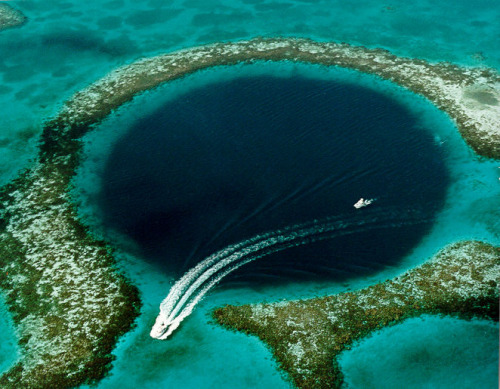
I’ve been here! I have snorkeled over this thing! It is terrifying! The water around the hole is so shallow you can’t even swim over the coral without bumping it, and then there’s a little slope down, and then it just fucking drops off into the abyss! When you’re over the hole the water temperature drops like 10 degrees and it’s midnight blue even when you’re right by the surface. Anyway. The Great Blue Hole is a massive underwater cave, and its roughly 410 feet deep. Overall, it’s a relatively safe area to swim. It’s a popular tourist attraction and recreational divers can even go down and explore some of the caves. People do die at the Blue Hole, but it is generally from a lack of diving experience rather than anything sinister going on down in the depths. My rating for this one is 1/10 because I’ve been here and although it’s kinda freaky it’s really not that bad.
Lake Baikal, Russia
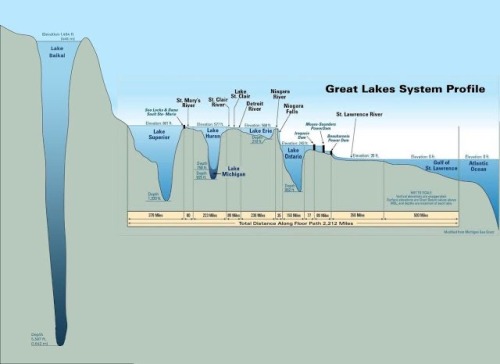
When I want to give myself a scare I look at the depth diagram of this lake. It’s so deep because it’s not a regular lake, it’s a Rift Valley, A massive crack in the earth’s crust where the continental plates are pulling apart. It’s over 5,000 feet deep and contains one-fifth of all freshwater on Earth. Luckily, its not any more deadly than a normal lake. It just happens to be very, very, freakishly deep. My rating for this lake is a 2/10 because I really hate looking at the depth charts but just looking at the lake itself isn’t that scary.
Jacob’s Well, Texas

This “well” is actually the opening to an underwater cave system. It’s roughly 120 feet deep, surrounded by very shallow water. This area is safe to swim in, but diving into the well can be deadly. The cave system below has false exits and narrow passages, resulting in multiple divers getting trapped and dying. My rating is a 3/10, because although I hate seeing that drop into the abyss it’s a pretty safe place to swim as long as you don’t go down into the cave (which I sure as shit won’t).
The Devil’s Kettle, Minnesota
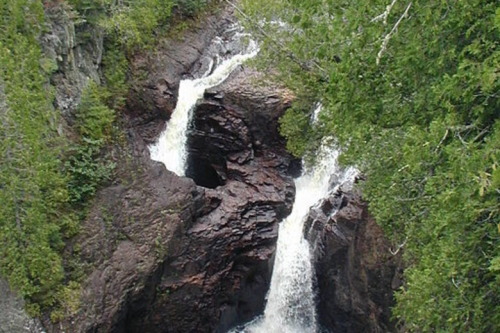
This is an area in the Brule River where half the river just disappears. It literally falls into a hole and is never seen again. Scientists have dropped in dye, ping pong balls, and other things to try and figure out where it goes, and the things they drop in never resurface. Rating is 4/10 because Sometimes I worry I’m going to fall into it.
Flathead Lake, Montana
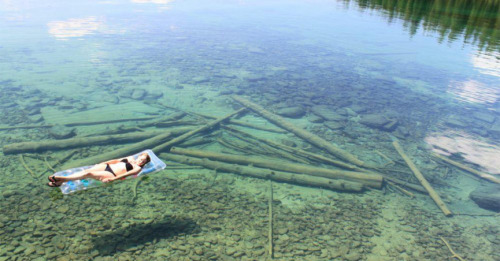
Everyone has probably seen this picture accompanied by a description about how this lake is actually hundreds of feet deep but just looks shallow because the water is so clear. If that were the case, this would definitely rank higher, but that claim is mostly bull. Look at the shadow of the raft. If it were hundreds of feet deep, the shadow would look like a tiny speck. Flathead lake does get very deep, but the spot the picture was taken in is fairly shallow. You can’t see the bottom in the deep parts. However, having freakishly clear water means you can see exactly where the sandy bottom drops off into blackness, so this still ranks a 5/10.
The Lower Congo River, multiple countries
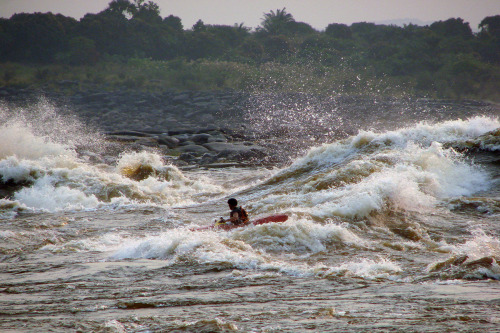
Most of the Congo is a pretty normal, if large, River. In the lower section of it, however, lurks a disturbing surprise: massive underwater canyons that plunge down to 720 feet. The fish that live down there resemble cave fish, having no color, no eyes, and special sensory organs to find their way in the dark. These canyons are so sheer that they create massive rapids, wild currents and vortexes that can very easily kill you if you fall in. A solid 6/10, would not go there.
Little Crater Lake, Oregon
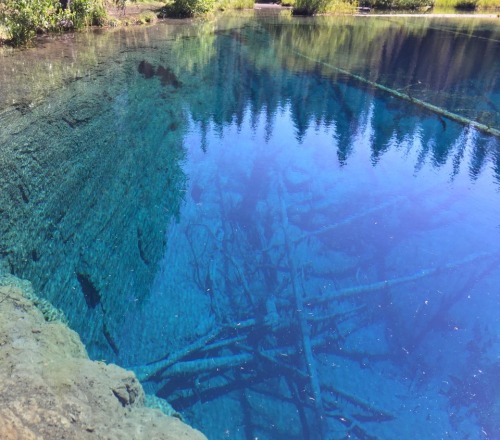
On first glance this lake doesn’t look too scary. It ranks this high because I really don’t like the sheer drop off and how clear it is (because it shows you exactly how deep it goes). This lake is about 100 feet across and 45 feet deep, and I strongly feel that this is too deep for such a small lake. Also, the water is freezing, and if you fall into the lake your muscles will seize up and you’ll sink and drown. I don’t like that either. 7/10.
Grand Turk 7,000 ft drop off

No. 8/10. I hate it.
Gulf of Corryvreckan, Scotland
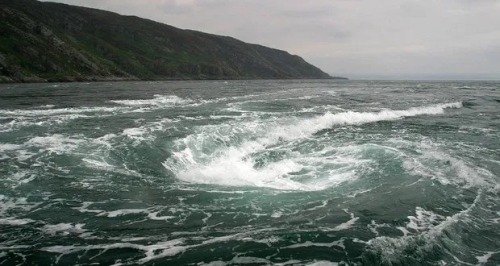
Due to a quirk in the sea floor, there is a permanent whirlpool here. This isn’t one of those things that looks scary but actually won’t hurt you, either. It absolutely will suck you down if you get too close. Scientists threw a mannequin with a depth gauge into it and when it was recovered the gauge showed it went down to over 600 feet. If you fall into this whirlpool you will die. 9/10 because this seems like something that should only be in movies.
The Bolton Strid, England
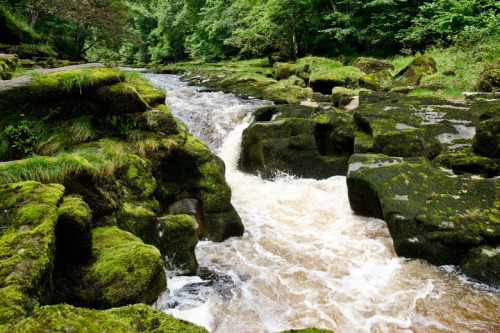
This looks like an adorable little creek in the English countryside but it’s not. Its really not. Statistically speaking, this is the most deadly body of water in the world. It has a 100% mortality rate. There is no recorded case of anyone falling into this river and coming out alive. This is because, a little ways upstream, this isn’t a cute little creek. It’s the River Wharfe, a river approximately 30 feet wide. This river is forced through a tiny crack in the earth, essentially turning it on its side. Now, instead of being 30 feet wide and 6 feet deep, it’s 6 feet wide and 30 feet deep (estimated, because no one actually knows how deep the Strid is). The currents are deadly fast. The banks are extremely undercut and the river has created caves, tunnels and holes for things (like bodies) to get trapped in. The innocent appearance of the Strid makes this place a death trap, because people assume it’s only knee-deep and step in to never be seen again. I hate this river. I have nightmares about it. I will never go to England just because I don’t want to be in the same country as this people-swallowing stream. 10/10, I live in constant fear of this place.
Honorable mention: The Quarry, Pennsylvania
I don’t know if that’s it’s actual name. This lake gets an honorable mention not because it’s particularly deep or dangerous, but it’s where I almost drowned during a scuba diving accident.
Edit: I’ve looked up the name of the quarry, it’s called Crusty’s Quarry and is privately owned and only used for training purposes, not recreational diving.
how to learn new content and never forget it
save this for your next academic year and finals, and it’ll save your grades and time.
1. whenever you read a paragraph with new content, close the book/look away and ask yourself: “what have i just learned?” explaining the concept to yourself right away and asking follow-up questions will change the way you retain new material forever.
2. at first, it’ll be daunting, and it’ll be pretty hard to actually bring yourself to do this. trust me, it’ll be worth it - as this is scientifically proven one of the most effective study techniques.
3. to try this out, set yourself a timer for how long you estimate learning a concept might take. now take away 20% from that estimate. you won’t be able to reach this goal with basic highlighting and re-reading techniques - but with active recall, you will.
4. once you’ve understood the concept, use spaced repetition systems like anki flashcards to force yourself to retrieve this information in a set period of time. this way, your brain will always be reminded of this concept before it could possibly forget it.
5. teach it to others as much as you can. as with the old wisdom “see one, do one, teach one”, one of the only guarantees you’ve really gotten something is when you can effectively teach it.
hope these are helpful for you!!
more content like this on my instagram, @softmedstudent
-
 bouu26 liked this · 1 month ago
bouu26 liked this · 1 month ago -
 felipexnz-blog reblogged this · 1 month ago
felipexnz-blog reblogged this · 1 month ago -
 suxiyanssimp liked this · 2 months ago
suxiyanssimp liked this · 2 months ago -
 suxiyanssimp reblogged this · 2 months ago
suxiyanssimp reblogged this · 2 months ago -
 seasonofthewitch06 liked this · 4 months ago
seasonofthewitch06 liked this · 4 months ago -
 gandalfismyfather reblogged this · 4 months ago
gandalfismyfather reblogged this · 4 months ago -
 inthesuitcase liked this · 4 months ago
inthesuitcase liked this · 4 months ago -
 phantomyao liked this · 6 months ago
phantomyao liked this · 6 months ago -
 somerandomblogidkwhattonameit liked this · 6 months ago
somerandomblogidkwhattonameit liked this · 6 months ago -
 annafx0bf liked this · 6 months ago
annafx0bf liked this · 6 months ago -
 errorkingsposts liked this · 7 months ago
errorkingsposts liked this · 7 months ago -
 kuper5tons liked this · 7 months ago
kuper5tons liked this · 7 months ago -
 spiteful-studying reblogged this · 8 months ago
spiteful-studying reblogged this · 8 months ago -
 mockingbird32 reblogged this · 9 months ago
mockingbird32 reblogged this · 9 months ago -
 maccharfucker liked this · 9 months ago
maccharfucker liked this · 9 months ago -
 thatsadsparrow liked this · 9 months ago
thatsadsparrow liked this · 9 months ago -
 dennymann2 reblogged this · 1 year ago
dennymann2 reblogged this · 1 year ago -
 dennymann2 liked this · 1 year ago
dennymann2 liked this · 1 year ago -
 cypresswine reblogged this · 1 year ago
cypresswine reblogged this · 1 year ago -
 birdopinions reblogged this · 1 year ago
birdopinions reblogged this · 1 year ago -
 midtowns-second liked this · 1 year ago
midtowns-second liked this · 1 year ago -
 himikoslove reblogged this · 1 year ago
himikoslove reblogged this · 1 year ago -
 flowerfemmes reblogged this · 1 year ago
flowerfemmes reblogged this · 1 year ago -
 king-xerxes reblogged this · 1 year ago
king-xerxes reblogged this · 1 year ago -
 underredskyoverblueclouds liked this · 1 year ago
underredskyoverblueclouds liked this · 1 year ago -
 lostsoul-at-the-lake-tonight reblogged this · 1 year ago
lostsoul-at-the-lake-tonight reblogged this · 1 year ago -
 fyodorswife liked this · 1 year ago
fyodorswife liked this · 1 year ago -
 filthycreaturegirl reblogged this · 1 year ago
filthycreaturegirl reblogged this · 1 year ago -
 bubbblegumpop liked this · 1 year ago
bubbblegumpop liked this · 1 year ago -
 flower-tea-fairies liked this · 1 year ago
flower-tea-fairies liked this · 1 year ago -
 flower-tea-fairies reblogged this · 1 year ago
flower-tea-fairies reblogged this · 1 year ago -
 skipping-tiles reblogged this · 2 years ago
skipping-tiles reblogged this · 2 years ago -
 revivingdawn reblogged this · 2 years ago
revivingdawn reblogged this · 2 years ago -
 onequarterofcentury reblogged this · 2 years ago
onequarterofcentury reblogged this · 2 years ago -
 morbidmeatbun liked this · 2 years ago
morbidmeatbun liked this · 2 years ago -
 shilde reblogged this · 2 years ago
shilde reblogged this · 2 years ago -
 shilde liked this · 2 years ago
shilde liked this · 2 years ago -
 ghostgirl919 liked this · 2 years ago
ghostgirl919 liked this · 2 years ago




